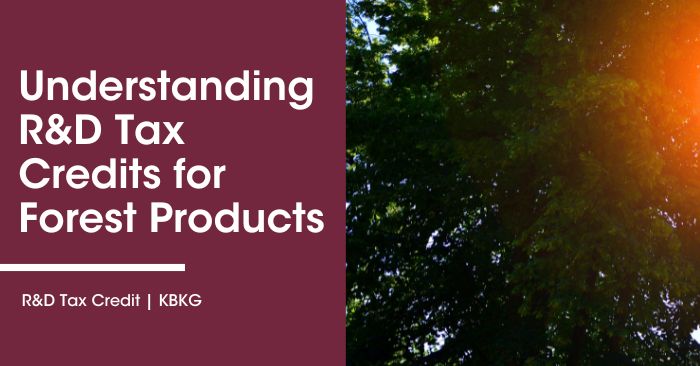Understanding R&D Tax Credits for Forest Products | KBKG
Companies in the forest products industry increasingly rely on research and development initiatives to optimize manufacturing, increase revenue, and create a competitive edge. Even small and medium-sized forestry businesses may qualify for valuable tax incentives related to R&D. Unfortunately, the U.S. Chamber of Commerce estimates that only 30% of eligible companies claim this credit. Explore our guide to research and development tax timber credits to take advantage of these federal programs.
Understanding R&D Tax Credits for Forest Products
According to the U.S. Forest Service, the U.S. Forest industry is one of the ten largest employers in 45 states, with 950,000 workers and an annual production of $50 billion. You may be able to claim a federal R&D tax credit for an innovation that improves the quality, reliability, efficiency, and performance of an aspect of the forest industry. The invention can be a new process, product, software program, or it can improve on existing technology. In addition to the federal credit, 40 states offer a state-level R&D credit.
If the innovation qualifies for the credit, it will lower your tax liability by $1 for every $1 spent on eligible research and development activities during the applicable tax year. In addition, you can claim a refund of $0.13 on every dollar spent on eligible research.
The IRS (Internal Revenue Service) does not limit the annual deduction amount you can claim under this credit. You can amend your returns to include this credit for up to three previous tax years, and you can deduct any unused expenses for up to 20 years in the future. Some companies, including start-ups and small businesses, can offset their payroll taxes with the R&D credit.
Identifying Eligible Tax Credit Opportunities
R&D tax credits for the forest products industry extend to a diverse range of niche areas and subsectors. You may qualify for the credit if your forestry business engages in research related to new or improved manufacturing processes, wood processing technologies, harvesting, and wood and non-wood product development. To assess whether a project qualified for the R&D credit, the activities associated with the project must pass each of the following four tests:
- There must be a defined permitted purpose at the outset of the research project related to a new or improved business component’s functionality, performance, reliability, quality, or composition. The research does not have to be new to the industry; it must just be new to the taxpayer performing the study.
- The activities performed must fundamentally rely on principles of physical sciences, biological sciences, computer science, or engineering.
- The activity must intend to discover information to eliminate uncertainty concerning the capability or method for developing or improving a product or process or the appropriateness of the product design.
- The qualifying activities must include a process of experimentation relying upon simulation, evaluation of alternatives, confirmation of hypotheses through trial and error, testing and/or modeling, or refining or discarding of hypotheses.
Some of the types of projects that could qualify for the credit include:
- Engineering efforts to develop new processes or materials to increase product durability.
- Developing new products to meet market demands.
- Optimizing workflows to decrease maintenance downtime or improve production, safety, and quality.
How KBKG Can Help
If your business works on research projects within the forestry products industry, you may be eligible to claim the R&D tax credit. Our team at KBKG is here to guide you through the intricacies of calculating the credit and is happy to help in any way we can.


